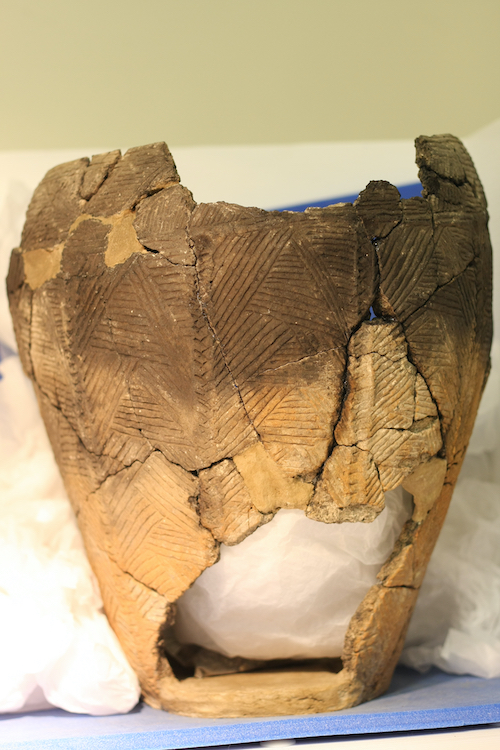
DSC00092A Grooved Ware People Flickr
Skara Brae is a 5,000 year old gift from the past — the Neolithic settlement of Skara Brae. It's located in Scotland's far flung Orkney Islands, beside the windswept Bay of Skaill. It's a must visit destination in Scotland for history buffs. Along with other Neolithic Orkney ruins, Skara Brae became a UNESCO World Heritage Site in 1999.

Dongnae Patriots Tomb Wall Grooved Ware People Flickr
Its manufacturers are sometimes known as the Grooved ware people. Unlike the later Beaker ware, Grooved culture was not an import from the continent but seems to have developed in Orkney, early in the 3rd millennium BC, and was soon adopted in Britain and Ireland. [1]

Kookaburra 3 Grooved Ware People Flickr
3D reconstruction of an Unstan Ware pot. Grooved Ware, however, with its flat bottom and intricate decoration of scored grooves, was more common in the larger, and more recent, settlements, such as Skara Brae and Barnhouse. The Grooved Ware people buried their dead in increasingly larger, and more monumental, cairns such as Maeshowe.

DSC00344 SONY DSC Grooved Ware People Flickr
Grooved Ware was the first widespread, flat-bottomed pottery in Britain and seems to have developed in Orkney, probably at sites such as the Ness of Brodgar, before spreading across the whole of Britain and Ireland.

DSC05281 SONY DSC Grooved Ware People Flickr
The Grooved Ware complex in Later Neolithic Britain has proved a perplexing phenomenon for prehistorians. While originally identified by Stuart Piggott as one of a series of 'Secondary Neolithic Cultures', it was later recognized as a special-purpose assemblage, connected with inter-regional contacts between socially pre-eminent groups.

Buddah's Birthday Sinwonsa Temple South Korea Grooved Ware People
History of Woodhenge Woodhenge is a Neolithic timber monument built in about 2500 BC, around the same time as Stonehenge, and only 2 miles away to the north-east. It was formed of six concentric ovals of standing posts, surrounded by a bank and ditch, which were built to align with the summer solstice sunrise.

New discoveries about Stonehenge Lynne Kelly
Grooved Ware is a pottery style current in Britain and Ireland during the Late Neolithic. It is flat based and may be plain or decorated. Where decorated this may be done in a number of ways according to sub-style, for instance grooving, incision, impression, and applied or other plastic decoration all of which are decorative techniques.

Stonehenge builders´ diet habits revealed at exhibition Daily Mail Online
The Megalithic Grooved Ware People of Great Britain "The Book of Hiram," written by Knight and Lomas in 2004, focuses on megalithic builders from the Neolithic period (12,000-4,000 years ago) whose direct work includes the world-renowned Stonehenge in Wiltshire, England, Newgrange in the Boyne Valley, Ireland, and The Ring of Brodgar in Scotland.

DSC05276 SONY DSC Grooved Ware People Flickr
The Grooved Ware People were primarily pastoralists who raised cattle and ate seafood, evident by the many fish bones and shells found in the middens, but excavations in 1972 discovered seed grains that suggested barley may have been cultivated. Image Credit : Shadowgate - CC BY 2.0

DSC05285 SONY DSC Grooved Ware People Flickr
Jetzt die Gelegenheit nutzen und hochwertige Zelte zu einem günstigen Preis erwerben. Luftzelte in diversen Ausführungen - passend für Ihr Wohnmobil oder Ihren Wohnwagen.

DSC05193 SONY DSC Grooved Ware People Flickr
Corded Ware pottery in the Museum für Vor- und Frühgeschichte (Berlin). c. 2500 BC. The origins and dispersal of Corded Ware culture is one of the pivotal unresolved issues of the Indo-European Urheimat problem, and there is a stark division between archaeologists regarding the origins of Corded Ware. The Corded Ware culture has long been.

DSC05282 SONY DSC Grooved Ware People Flickr
Wir machen's richtig fest. Qualität zum fairen Preis! Große Auswahl zum günstigen Preis. Jetzt beim Profi kaufen und sparen.

DSC05289 SONY DSC Grooved Ware People Flickr
Language links are at the top of the page across from the title.

DSC05284 SONY DSC Grooved Ware People Flickr
Carlin, N. 2017. Getting into the groove: exploring the relationship between Grooved Ware and developed passage tombs in Ireland c. 3000-2700 BC. Proceedings of the Prehistoric Society, 83. Abstract: This paper examines the relationship between the use of late Irish passage tombs and the development of the British and Irish Grooved Ware complex.

DSC05272 SONY DSC Grooved Ware People Flickr
Skara Brae, Orkney Yellow Book (CC BY-NC-SA) Skara Brae is a Neolithic Age site, consisting of ten stone structures, near the Bay of Skaill, Orkney, Scotland. Today the village is situated by the shore but when it was inhabited (c.3100-2500 BCE) it would have been further inland.

Jogosanseong sign Grooved Ware People Flickr
During the Neolithic Orkney's population of farmers and pastoralists, known as the Groove ware people, inhabited extensive village settlements, built huge megalithic complexes and developed.